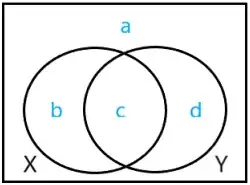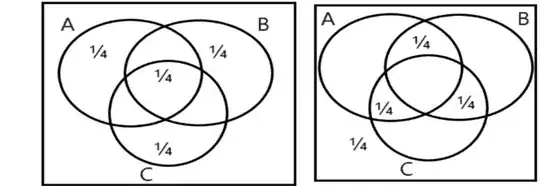
In the above universe, $a,b,c$ and $d$ denote probabilities. \begin{align}&\text{events }X \text{ and } Y \text{ are }\textbf{independent}
\\\iff &P(X\cap Y)=P(X)P(Y)
\\\iff &\frac{c}{a+b+c+d}=\frac{b+c}{a+b+c+d}\times\frac{c+d}{a+b+c+d}
\\\iff &ac=bd.\end{align}
Imagine two events $X$ and $Y$ that are not mutually exclusive, such that $P(X) = 0.3 \,$ and $P(Y)=0.4.$ Consider their Venn diagram.
It should be clear that the only value of $P(X \cap Y)$ that makes $X$ and $Y$ independent is $P(X \cap Y) = 0.12.$
$$b=0.3-c\tag1$$$$d=0.4-c\tag2$$$$a=1-0.3-(0.4-c)=0.3+c\tag3$$
For events $X$ and $Y$ to be independent, $$ac=bd\tag4.$$
Solving $(1),(2),(3),(4)$ gives $$c=0.12,$$ as required.
Independence of events is not straightforward to intuit from Venn diagrams (unlike mutual exclusivity, which is observed by inspecting their intersection).
For example:

$$ \begin{array}{r} \begin{array}{c|c|c}
\style{font-family:inherit}{} & \style{font-family:inherit}{U_1} & \style{font-family:inherit}{U_2} & \style{font-family:inherit}{U_3}
\\\hline
\style{font-family:inherit}{P(X\cap Y)} & 0 & \frac14 & \frac14
\\[0pt]\hline
\style{font-family:inherit}{P(X)P(Y)} & \frac14\times\frac12=\frac18 & \frac14\times\frac34=\frac38 & \frac12\times\frac12=\frac14
\\[0pt]\hline
\style{font-family:inherit}{\therefore X\text{ and }Y\text{ are}\ldots} & \textbf{dependent} & \textbf{dependent} & \textbf{independent}
\end{array}\hskip-5.5pt \end{array} $$
[Universe $U_1$ above is also an example of the fact that for events with nonzero probabilities, $\big(\text{mutual exclusivity}\implies\text{dependence}\big)$.]
Two more examples, but involving $3$ events: in each case, events $A,B$ and $C$ are pairwise independent yet not (mutually) independent $\big($since $P(A \cap B\cap C) \neq P(A)P(B)P(C)\,\big):$

When the probability experiment has just $2$ trials, a table like this is a good way to understand/visualise conditional probability as working in a reduced sample space:
$$ \begin{array}{r} \begin{array}{c|c|c}
\style{font-family:inherit}{\text{time of complaint}\bigg\\ \text{reason for complaint}} & \style{font-family:inherit}{\textbf E\text{lectrical}} & \style{font-family:inherit}{\textbf M\text{echanical}} & \style{font-family:inherit}{\textbf L\text{ooks}}
\\\hline
\style{font-family:inherit}{\textbf D\text{uring guarantee period}} & 18\% & 13\% & 32\%
\\[0pt]\hline
\style{font-family:inherit}{\textbf A\text{fter guarantee period}} & 12\% & 22\% & 3\%
\end{array}\hskip-5.5pt \end{array} $$
The calculation (notice that the figure ‘$32$’ was obtained from the intersection of column $L$ and row $D$) $$P(L|D)=\frac{P(L\cap D)}{P(D)}=\frac{32}{18+13+32}=51\%\neq32\%+3\%=P(L)$$ shows that $L$ and $D$ are dependent events.



